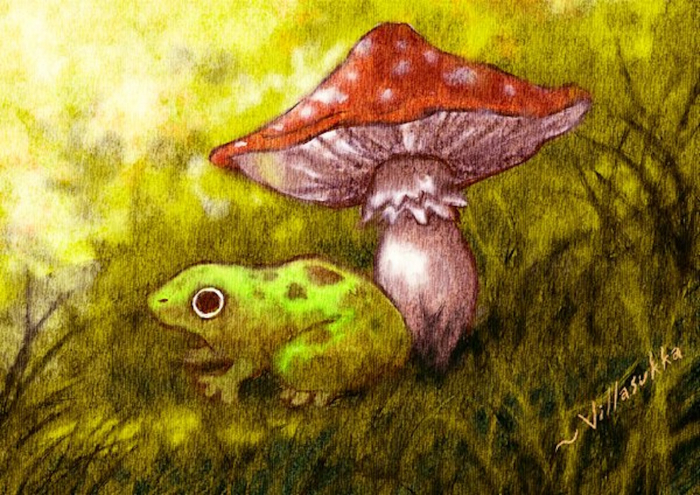It is the most drawn mushroom, the children’s favourite: red, with flashy white polka dots. It is often represented with a toad hiding under its umbrella or clinging on top of it, and this is the reason why the mushroom is also widely known as ‘toadstool.’ It is the Amanita muscaria, a toxic mushroom which can be easily found also in our woods.
The Amanita muscaria is one of the most ancient and powerful psychotropic mushrooms: judging from some rock paintings found in the Sahara, it seems that its hallucinogenic effects were already known during the Palaeolithic period (9000–7000 B.C.). Used within shamanistic contexts like other ‘magic’ mushrooms, the Amanita was at the core of a flourishing trade that extended to the Siberia. Its psychotropic effects are so strong that they don’t run out with a single intake: one of the alkaloids contained in the mushroom (the muscimol) survives to digestion and is expelled intact through the urinary tract. This is why people once used to drink the urine of those who had eaten the mushroom, reaching the number of five or six passages.
But the Amanita was commonly used also as a trap for flies, whence the epithet muscaria: indeed, the mushroom was believed to attract and kill these bugs, therefore it was placed on window-sills. In fact, the flies that alight on the cuticle of the Amanita’s cap and lick it, manifest the symptoms of intoxication within 20 minutes; they can’t fly anymore, they lack coordination in their movements, they start shaking and finally they drop dead as a doornail, turned on their back and with their paws in the air.
And yet, according to Giorgio Samorini, a researcher specialized in psychotropic plants (the one who discovered the abovementioned Saharian paintings), Amanita’s reputation of ‘fly-killer’ hides a much more fascinating possibility.
The flies poisoned by the mushroom seem dead but they are actually not dead at all: if we attentively look at them under a magnifying glass, we can notice their peristaltic spasms and in fact, after having been lying with their paws in the air – sometimes for hours – they wake up and take flight as if nothing had happened.
It seems rather unlikely that flies are attracted and stunned by the mushroom because of a simple ‘evolutionistic accident.’ In his article Fly-agaric, flies and toads: a new hypothesis (1999), Samorini therefore supposes that bugs deliberately alight on the Amanita, with the express purpose to be intoxicated by the fly agaric. Apparently these bugs are not the only animals in nature that take drugs on purpose: cows, elephants, cats, reindeers, goats, birds, butterflies, ants are only a few of the many species that really seem to appreciate ‘altered states’ of consciousness.
And the toads? What do they do perched on top of the mushroom, like Alice’s caterpillar smoking the hookah? Maybe they are less interested in psychedelia than in the pleasures of the palate: in the proximity of an Amanita, they can effortlessly enjoy an endless parade of dulled, lethargic and completely “freaked out” flies... the perfect preys for their quick and lethal tongue.



